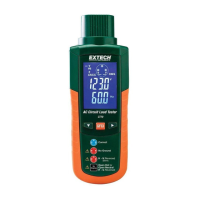8 CT70-en-GB_V8.5 2/19
Test 5: Impedance (Z) Measurements
The impedance measurement capability of the CT70 is used to check Hot and Neutral impedance
when voltage drop measurements are too high (greater than 5%). To determine where the problem
is, measure the impedances and analyze the data as follows:
If one impedance measurement is exceedingly higher than the other then the problem is
with the conductor that shows the higher impedance.
If both impedances are high the problem could be an undersized conductor, a faulty load,
or poor connections.
Ground impedance should be less than 1 , preferably in the 0.25 region to ensure that the
ground conductor can safely return current when necessary.
Surge suppressors require good grounding to adequately protect against transient voltages.
Note: A small amount of current is applied to the ground conductor during impedance measurements
and can trip a GFCI circuit.
High Impedance Troubleshooting Suggestions
Problems Likely Causes Probable Solutions
High hot and/or neutral impedance
(Limit: 0.048 / ft of 14 AWG wire)
Excessive loading Redistribute loads
High hot and/or neutral impedance
(Limit: 0.03 / ft of 12 AWG wire)
Undersized wiring
Check code and rewire if
necessary
High hot and/or neutral impedance
(Limit: 0.01 / ft of 10 AWG wire)
High resistance connection in
the circuit or at the panel
Locate bad connection and
rewire or replace
High Ground impedance (Limit: 1
for personal protection)
Undersized wiring
Check code and rewire if
necessary
High Ground impedance (Limit:
0.25 for equipment protection
High resistance connection in
the circuit or at the panel
Locate bad connection and
rewire or replace
www.GlobalTestSupply.com
Find Quality Products Online at: sales@GlobalTestSupply.com

